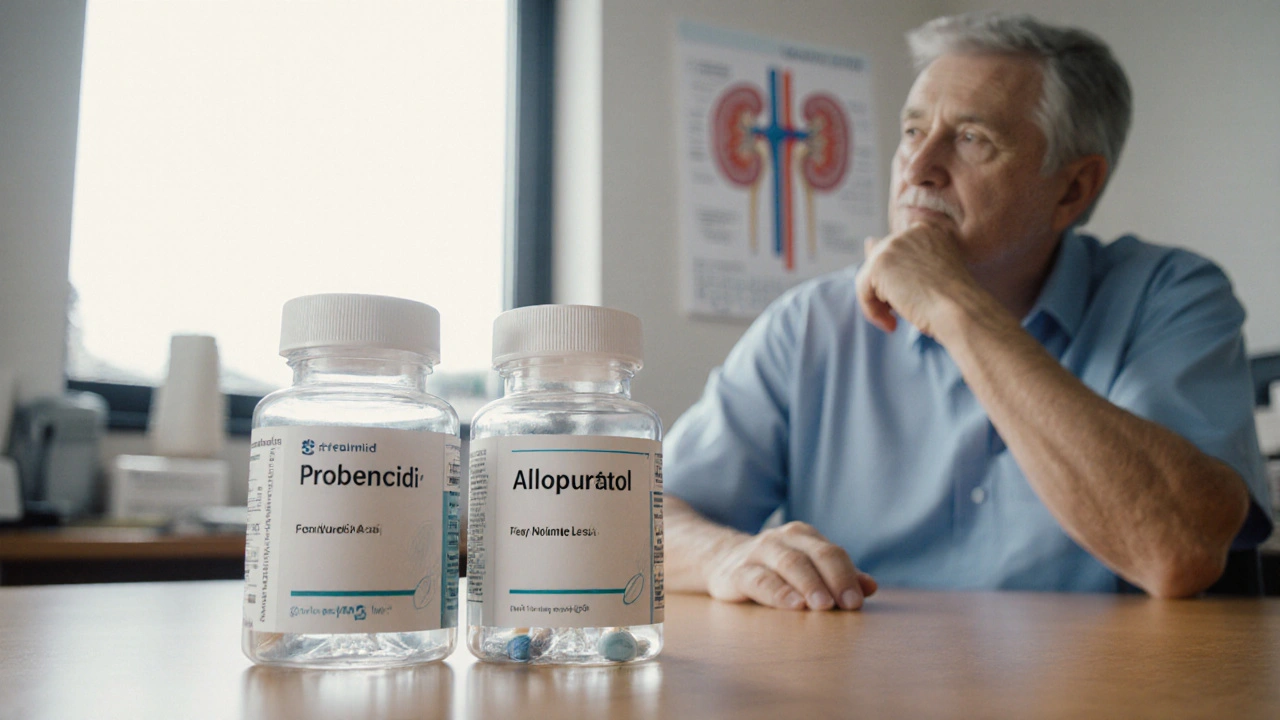Gout Medication Comparison Tool
Benemid (Probenecid)
Mechanism: Increases kidney excretion of uric acid
Dosage: 250 mg twice daily, up to 500 mg twice daily
Benefits: Effective for chronic gout, boosts antibiotic efficacy
Side Effects: Stomach upset Rash Kidney stones
Important: Requires healthy kidneys; avoid if creatinine clearance < 30 mL/min
Allopurinol
Mechanism: Reduces uric acid production
Dosage: Starts at 100-300 mg daily, may increase to 800 mg
Benefits: First-line treatment, widely available, low cost
Side Effects: Skin rash Liver issues Severe allergic reaction
Important: May cause rare but serious skin reactions
Febuxostat
Mechanism: Inhibits xanthine oxidase to reduce uric acid
Dosage: 40 mg once daily, can increase to 80 mg
Benefits: Good for those with kidney problems, no dietary restrictions
Side Effects: Nausea Joint pain Cardiovascular risk
Important: May increase heart disease risk in some patients
Drug Selection Guide
Consider these factors when choosing a medication:
- Kidney Function: Benemid requires healthy kidneys; Allopurinol and Febuxostat are safer for impaired kidney function
- Cost: Allopurinol is usually the least expensive
- Side Effect Profile: Febuxostat has higher cardiovascular risk; Allopurinol can cause severe rashes
- Convenience: All three are taken once daily
Key Takeaways
- Benemid is a uricosuric drug that helps the kidneys remove excess uric acid.
- Allopurinol and febuxostat work by lowering uric‑acid production, not by increasing excretion.
- Kidney function, cost, and side‑effect profile decide which drug fits you best.
- Switching drugs requires a short overlap or wash‑out period to avoid gout flares.
- Always talk to a pharmacist or doctor before changing your regimen.
If you’ve been prescribed Benemid (also known as Probenecid) for gout or high uric‑acid levels, you might wonder whether there’s a better pill out there. The good news is that modern medicine offers several ways to control uric acid, each with its own strengths and drawbacks. This guide walks you through what Benemid does, what the most common alternatives are, and how to pick the right option for your health situation.
Benemid is a uricosuric medication that increases the kidneys' ability to excrete uric acid, thereby lowering blood urate levels. Its active ingredient is Probenecid, first approved in the 1950s and still used today for chronic gout management and to boost certain antibiotics' effectiveness.Benemid works by blocking the re‑absorption of uric acid in the renal tubules, which means more uric acid leaves the body in the urine. Typical dosing starts at 250mg twice daily, with a possible increase to 500mg twice daily after a few weeks if serum urate stays high. The drug is taken after meals to improve absorption and reduce stomach upset.
Side effects are generally mild but can include stomach cramps, nausea, and a rash. A rarer but serious issue is kidney stone formation, especially if you don’t drink enough water. Because Benemid relies on healthy kidneys, it isn’t recommended for patients with severe renal impairment (creatinine clearance <30mL/min).
Common Alternatives to Benemid
When doctors talk about "alternatives," they usually refer to drugs that either lower uric‑acid production or use a different excretion pathway. Below are the most frequently prescribed options.
Allopurinol is a xanthine oxidase inhibitor that blocks the enzyme responsible for turning purines into uric acid. It’s the first‑line treatment for most gout patients and has been on the market since the 1960s.- Typical dose: 100mg daily, titrated up to 300mg or more based on urate levels.
- Key side effects: rash, liver enzyme elevation, and in rare cases, severe hypersensitivity (especially in patients with renal impairment).
- Best for: patients who need stable, long‑term uric‑acid reduction and have good kidney function.
- Typical dose: 40mg once daily, can increase to 80mg if needed.
- Key side effects: liver enzyme rise, cardiovascular events (caution in patients with heart disease).
- Best for: people who cannot tolerate allopurinol or have moderate renal impairment.
- Typical dose: 200mg once daily with a xanthine oxidase inhibitor.
- Key side effects: kidney stones, increased serum creatinine, and rash.
- Best for: patients already on allopurinol or febuxostat who still have high urate levels.
- Typical regimen: 8mg infusion every two weeks.
- Key side effects: infusion reactions, development of antibodies, and rare anaphylaxis.
- Best for: chronic gout patients who have failed oral therapy.
- Typical dose for flare prevention: 0.6mg once or twice daily.
- Key side effects: diarrhea, nausea, and rare muscle toxicity.
- Best for: short‑term control of gout attacks while other urate‑lowering drugs take effect.
- Typical dose: Indomethacin 50mg three times daily for 5‑7 days.
- Key side effects: stomach ulcer, kidney irritation, and increased blood pressure.
- Best for: rapid pain relief when a flare occurs, especially if NSAIDs are not contraindicated.

Side‑by‑Side Comparison
| Drug | Mechanism | Typical Dose | Main Side Effects | Kidney Considerations | Cost (approx. US$ per month) |
|---|---|---|---|---|---|
| Benemid (Probenecid) | Uricosuric - blocks renal re‑absorption of uric acid | 250‑500mg twice daily | Kidney stones, GI upset, rash | Requires good renal function; not for CrCl <30mL/min | ~$20‑30 |
| Allopurinol | Xanthine oxidase inhibitor - reduces uric‑acid production | 100‑300mg daily (titrated) | Rash, liver enzymes, rare hypersensitivity | Safe down to CrCl 20mL/min with dose adjustment | ~$10‑15 |
| Febuxostat | Xanthine oxidase inhibitor (non‑purine) | 40‑80mg daily | Liver enzyme rise, cardiovascular risk | Can use in moderate renal disease (CrCl>30mL/min) | ~$30‑45 |
| Lesinurad | Uric‑acid re‑absorption inhibitor (add‑on) | 200mg once daily with another urate‑lowerer | Kidney stones, creatinine rise | Monitor creatinine; avoid if CrCl <30mL/min | ~$60‑80 |
| Pegloticase | Recombinant uric‑acid oxidase - converts uric acid to allantoin | 8mg IV every 2 weeks | Infusion reactions, antibodies | Generally safe for kidneys; monitor for infusion issues | ~$1,200‑1,500 |
Here’s where the Benemid alternatives really diverge: if kidney health is a concern, an enzyme‑inhibitor like allopurinol or febuxostat often makes more sense. If cost is a big factor, the older drugs win hands down. For severe, refractory cases, the pricey IV option may be the only answer.
How to Choose the Right Treatment
Picking a gout medication isn’t a one‑size‑fits‑all decision. Consider these three questions before you settle on a pill:
- Do I have kidney problems? If your creatinine clearance is below 30mL/min, you’ll likely avoid Benemid and lesinurad. Allopurinol (with a lower dose) or febuxostat become safer bets.
- What’s my budget? Generic allopurinol and benemid are cheap, while pegloticase can exceed a thousand dollars per month. Insurance coverage varies, so check your plan.
- Am I prone to skin reactions or heart issues? Allopurinol hypersensitivity, especially in people with the HLA‑B*58:01 allele, can be life‑threatening. Febuxostat carries a boxed warning for cardiovascular events. If either risk scares you, benemid or colchicine may be alternatives, provided your kidneys are OK.
Once you answer these, talk to your pharmacist or doctor. They’ll look at your lab values (serum urate, kidney function, liver enzymes) and help you start at the right dose.

Switching Between Therapies
Sometimes the first drug just doesn’t work, or side effects become intolerable. Here's a quick roadmap for changing meds safely:
- Stop the old drug. For benemid, a short wash‑out of 48‑72hours reduces the chance of overlap side effects.
- Begin the new drug at a low dose. Allopurinol, for example, often starts at 100mg daily, even if you were on a higher benemid dose.
- Watch for gout flares. Starting any urate‑lowering drug can mobilize uric acid stores and spark a flare. Doctors usually prescribe colchicine or an NSAID for the first month.
- Retest serum urate after 2‑4 weeks. Adjust the dose based on the result.
- Stay hydrated. This is crucial when moving from a uricosuric (benemid) to a production‑inhibitor (allopurinol) to keep kidney stones at bay.
Never make the switch on your own-some combinations (e.g., benemid + allopurinol) can cause dangerous uric‑acid spikes.
Frequently Asked Questions
Can I take Benemid and Allopurinol together?
Combining a uricosuric (Benemid) with a xanthine oxidase inhibitor (Allopurinol) can dramatically lower uric acid, but it also raises the risk of kidney stones and sudden drops in serum urate that trigger flares. Doctors sometimes use a low dose of both for resistant gout, but only under close monitoring and with plenty of fluids.
Why would my doctor switch me from Benemid to Febuxostat?
If your kidneys aren’t working well, benemid’s uricosuric action loses effectiveness. Febuxostat lowers uric‑acid production without relying on kidney filtration, so it’s a better fit for moderate renal impairment.
Is Benemid safe during pregnancy?
There’s limited data, and benemid crosses the placenta in animal studies. Most guidelines recommend avoiding it during pregnancy unless the benefit clearly outweighs the risk.
How long does it take for Benemid to lower uric acid?
You’ll usually see a 10‑20% drop in serum urate within 1‑2 weeks, with the full effect appearing after about 4‑6 weeks of consistent dosing.
What should I do if I develop a kidney stone while on Benemid?
Stop benemid immediately, increase fluid intake, and seek medical attention. Your doctor may switch you to an allopurinol‑based regimen and prescribe a short course of a potassium citrate solution to prevent further stones.

Liliana Phera
October 5, 2025 AT 14:12You think Benemid is just another pill? Think again. The kidneys are the gatekeepers of uric acid, and any drug that forces them to work harder must be scrutinized under a harsh light. If your kidneys aren’t pristine, you’re practically signing a death warrant for yourself. The aggressive push to boost excretion ignores the downstream chaos of stones and electrolyte imbalance.
Dean Briggs
October 6, 2025 AT 18:26When you line up Benemid, Allopurinol, and Febuxostat side by side, the differences become a cascade of clinical considerations.
First, the mechanism: Benemid is a uricosuric agent, meaning it tells the kidneys to dump more uric acid, while Allopurinol and Febuxostat are xanthine oxidase inhibitors that cut production at its source.
Second, the dosing convenience: Benemid usually requires twice‑daily dosing, whereas the other two can be taken once daily, which matters for adherence.
Third, renal function plays a starring role; Benemid demands a creatinine clearance above 30 mL/min, Allopurinol tolerates moderate impairment, and Febuxostat is explicitly designed for patients with reduced kidney function.
Fourth, cost: Allopurinol is the budget‑friendly workhorse, Benemid sits in the middle, and Febuxostat, being newer, often carries a heftier price tag.
Fifth, side‑effect profiles diverge: Benemid can precipitate kidney stones if hydration is inadequate, Allopurinol carries the rare but dreaded Stevens‑Johnson syndrome, and Febuxostat raises a flag for cardiovascular events in susceptible individuals.
Sixth, drug interactions differ; Benemide’s uricosuric effect can boost certain antibiotics, Allopurinol may need dose adjustments with azathioprine, and Febuxostat has fewer notorious interactions.
Seventh, the patient’s lifestyle matters: those who can maintain high fluid intake may tolerate Benemid, whereas patients with dietary restrictions might lean toward the production inhibitors.
Eighth, the timeline of effect varies: uricosurics can show a rapid drop in serum urate, while xanthine oxidase inhibitors may take weeks to reach steady‑state levels.
Ninth, genetic factors such as HLA‑B*58:01 influence Allopurinol safety, a consideration not present with Benemid or Febuxostat.
Tenth, the physician’s comfort with monitoring: Benemid requires regular urine pH checks, while Allopurinol and Febuxostat need routine liver function tests.
Eleventh, the risk of gout flares during initiation is present across all three, but tapering strategies differ.
Twelfth, the presence of comorbidities like hypertension or heart disease nudges the decision toward Febuxostat, despite its cost.
Thirteenth, insurance formularies often dictate which drug is readily accessible to the patient.
Fourteenth, patient preference for pill burden can tip the scales toward a once‑daily regimen.
Fifteenth, always remember that any switch should be overseen by a healthcare professional to avoid precipitating acute attacks.
Sadie Speid
October 7, 2025 AT 22:30Benemid can be a solid option if you’re young, have healthy kidneys, and can stay well‑hydrated. It’s especially handy when you need to boost the effect of certain antibiotics. Just keep an eye on stone formation – sip water like it’s your job.
Sue Ross
October 8, 2025 AT 23:46The interplay between renal clearance and uric‑acid handling is fascinating. While Benemid leans on the kidneys, Allopurinol and Febuxostat sidestep that requirement entirely. That distinction often guides the choice for patients with chronic kidney disease.
Rohinii Pradhan
October 10, 2025 AT 03:50In a clinical discourse, one must acknowledge that the lexical elegance of the term “uricosuric” belies the pragmatic pitfalls inherent to Benemid therapy. The requisite renal competence imposes a non‑trivial exclusion criterion, rendering the agent unsuitable for a substantial subset of gout patients whose glomerular filtration rates languish below the stipulated threshold. Moreover, the specter of nephrolithiasis, albeit mitigable through diligent hydration, nevertheless persists as a salient adverse event. Consequently, while the pharmacodynamic allure of augmenting uric‑acid excretion is intellectually appealing, the pragmatic physician must weigh these considerations against the more universally tolerable xanthine oxidase inhibitors.
Anna-Lisa Hagley
October 11, 2025 AT 07:53Benemid’s reliance on renal excretion makes it a fragile choice; any dip in kidney health renders the drug ineffective and potentially harmful.
A Walton Smith
October 12, 2025 AT 11:56Allopurinol is cheap.
Alisa Hayes
October 13, 2025 AT 16:00From a practical standpoint, the decision often comes down to insurance coverage and patient preference. If cost is a primary concern, Allopurinol usually wins, but for those with contraindications, Febuxostat shines. Benemid remains a niche player for patients with robust renal function who can maintain high fluid intake.
Mariana L Figueroa
October 14, 2025 AT 20:03Helpful tip: when starting Benemid, set a reminder to drink at least eight glasses of water a day; it dramatically reduces stone risk. Also, monitor uric‑acid levels after two weeks to see if the dose needs tweaking.
mausumi priyadarshini
October 16, 2025 AT 00:06It’s worth noting, however, that while Benemid appears effective, the literature is peppered-with occasional, albeit rare, reports of nephrolithiasis, hyperuricosuria, and gastrointestinal upset; consequently, one might argue that the drug’s utility is overstated, especially when safer alternatives exist, such as Allopurinol or Febuxostat, which carry a more favorable safety profile.
Carl Mitchel
October 17, 2025 AT 04:10Ethically speaking, prescribing a drug that can cause kidney stones when safer, cost‑effective options are available feels like a compromise of the Hippocratic oath. Patients deserve a regimen that minimizes risk and maximizes adherence.
Suzette Muller
October 18, 2025 AT 08:13From my experience helping patients manage gout, I’ve found that educating them about hydration when using Benemid makes a noticeable difference in tolerability. A simple daily water log can be surprisingly effective.
Lily Tung
October 19, 2025 AT 12:16Let us not overlook the subtle yet profound epistemological ramifications of favoring a uricosuric agent over a production inhibitor; the former presupposes an intact renal apparatus, thereby implicitly discriminating against a demographic beset by chronic kidney disease, a condition that is, regrettably, not uncommon among the gout-afflicted populace.
In contrast, xanthine oxidase inhibitors democratize therapeutic access, circumventing the renal bottleneck entirely.
Thus, the choice of Benemid is not merely a pharmacologic preference but a reflection of broader systemic biases that merit rigorous scrutiny.
Josh SEBRING
October 20, 2025 AT 16:20Yo, you’re over‑thinking this. If the doc says Benemid works, just take it and drink water-no need to dissect every nuance.